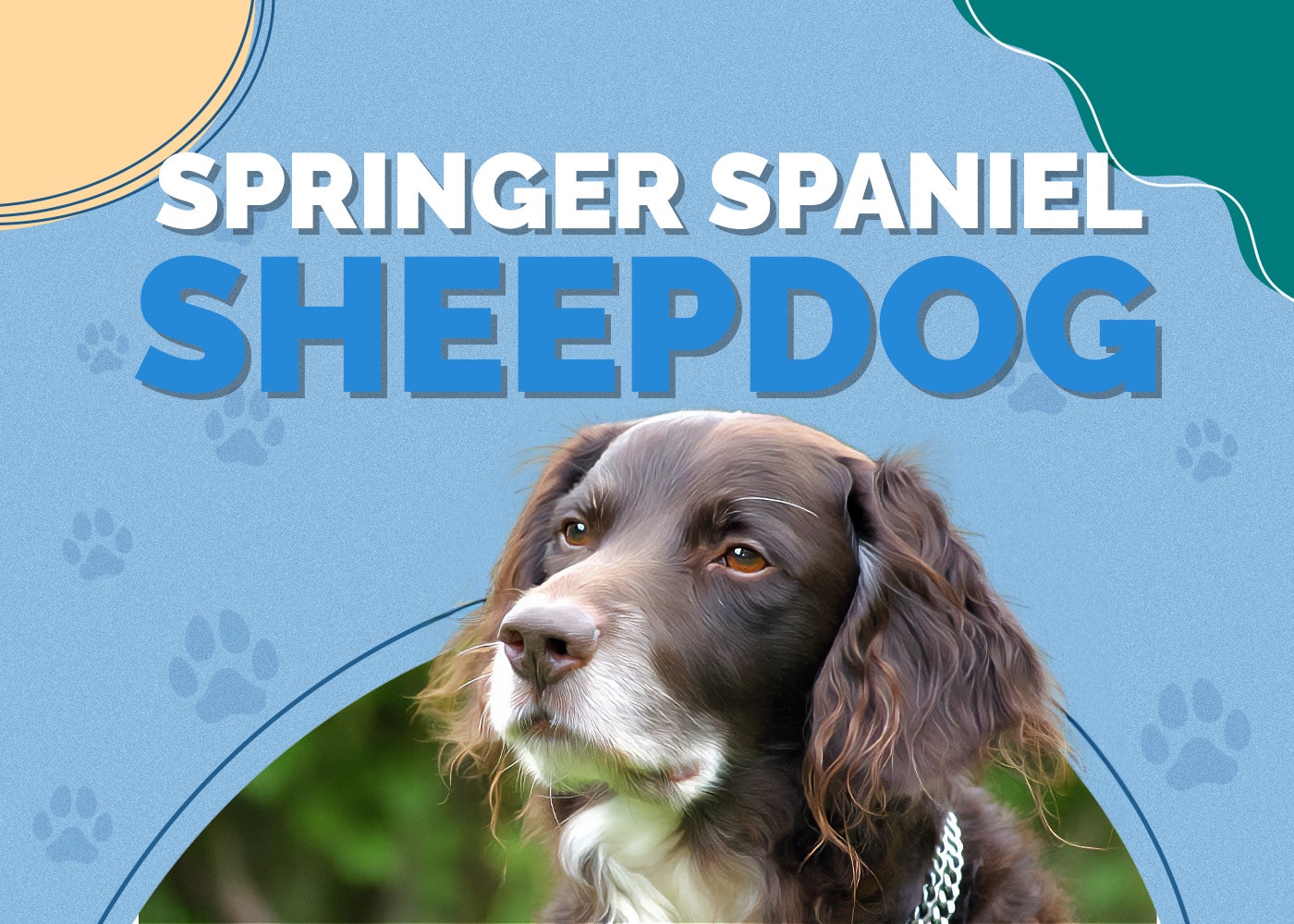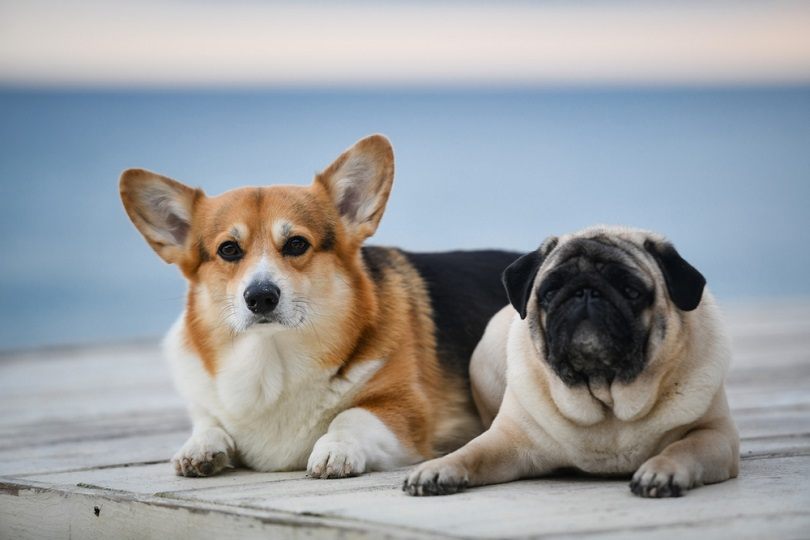Merle Goldendoodle: Facts, History & Origin (With Pictures)
By Kit Copson
Updated on

Click to Skip Ahead
The teddy-bear-like Goldendoodle is incredibly popular, which comes as no surprise given that the two parent breeds—the Golden Retriever and the Poodle—are two of the most beloved dog breeds in the U.S. In addition to being great companions, Goldendoodles are so sought-after because of their adaptability and diversity.
In this post, we’ll take a closer look at one of the most striking Goldendoodle coat color patterns—Merle—and explore the Goldendoodle’s history.
| Height: | 13 – 24 inches (Goldendoodles come in various sizes, ranging from petite/tiny to standard. Petite/tiny dogs may be even smaller than 13 inches) |
| Weight: | 10 – 90 pounds (ranging from petite/tiny to standard) |
| Lifespan: | 10 – 15 years |
| Colors: | Black, chocolate, red, white, gray, cream, gold, apricot, champagne, merle |
| Suitable for: | ll loving families, therapy training |
| Temperament: | Bubbly, cheerful, friendly, loving, intelligent, trainable |
Goldendoodle coat colors are vast and diverse. Merle coats, which appear when a dog inherits the Mm genotype (one merle allele and one non-merle allele), are irregularly patched with both areas of dark color and areas of diluted pigment, which results in a marbled effect. It’s common in certain breeds, like the Australian Shepherd and Border Collie, but it’s not so common in Goldendoodles.
When a dog inherits the Merle gene, it’s not just the coat that’s affected, but also the eyes. It’s common for Merle dogs to have blue eyes, and sometimes even eyes in different colors. That said, not all Merles will necessarily have blue eyes—other shades are possible, including light blue, green, and amber, ranging from pale to dark.
Merle Goldendoodle Breed Characteristics
The Earliest Records of Merle Goldendoodles in History

A modern hybrid (also known as a “designer breed”), Goldendoodles were first sold in the 1990s when breeders brought them into the public eye, though the year they were first bred is a point of uncertainty. However, it’s possible that they were first bred by Monica Dickens in 1969.
According to the Goldendoodle Association of North America, it’s likely that the success of the Labradoodle, another hybrid developed as a low-shedding dog suitable for guide dog training, served as inspiration for the marketing of Goldendoodles. The low-shedding Goldendoodle was developed for people who were fans of the Golden Retriever but couldn’t deal with the amount of shedding.
How Merle Goldendoodles Gained Popularity
Soon after they were brought to public attention in the late 1990s, Goldendoodles experienced a big surge in popularity thanks to their low-shedding coats, general good health (“hybrid vigor”), and wonderful temperaments. Known for their gentleness, devotedness, intelligence, and trainability, Goldendoodles quickly found their place in service training programs and many homes as lovely family companions.
To this day, the Goldendoodle’s popularity has not simmered down and continues to grow. Breeders develop these dogs in a wide variety of colors and patterns, including Merle, and sizes, ranging from petite/tiny/toy (around 10–15 pounds) to standard (50–90 pounds).
Merle Goldendoodles, in particular, are likely popular for the same reasons as other Goldendoodles, but with the added edge of their eye-catching coat color pattern.
Formal Recognition of the Merle Goldendoodle
The American Kennel Club (AKC) nor, to our knowledge, any other well-known clubs recognize Goldendoodles because they are not purebreds.
Furthermore, Goldendoodles can’t be registered in the AKC’s traditional registry, but they can be enrolled in the AKC Canine Partners Program, which allows mixed and hybrid breeds to take part in various activities and gain titles, like the AKC Canine Good Citizen title. Members of the AKC Canine Partners Program can’t compete in Conformation events, however.
As for the two Goldendoodle parent breeds, the Golden Retriever was first recognized by the AKC in 1925 and is currently ranked at number three on the breed popularity ranking. The Poodle was recognized in 1887 and is the seventh most popular breed on the ranking.
Top 3 Unique Facts About Merle Goldendoodles

1. Double Merle Genes Can Cause Health Issues
Responsible breeders avoid pairing two merles because this can result in double M genes. Dogs with double merle genes are at greater risk of certain health conditions, including heart, reproductive, and skeletal conditions. Blindness and deafness are also possible. For these reasons, responsible breeders only pair merles with non-merles.
2. Goldendoodles May Have Been First Bred by Charles Dickens’ Great-Granddaughter
Years before Goldendoodles became better known, it is believed that Monica Dickens, the great-granddaughter of famed English writer Charles Dickens, bred the first Goldendoodles in 1969. However, the Goldendoodle Association of North America explains that “the exact date of conception is unknown.”
3. Goldendoodle Coats Come in Various Types
Not all Goldendoodle coats are curly—they can also be wavy or straight. It all depends on the genes they inherit from their parents. Some breeders purposefully develop their puppies to have a specific coat type.

Does a Merle Goldendoodle Make a Good Pet?
Goldendoodles are famed for their family-friendliness. Of course, you have to put the same amount of work into socializing and training a Goldendoodle as you would put into any breed of dog, but proper socialization helps produce a dog that is well-mannered, confident in social situations, friendly, and non-aggressive. Fortunately, Goldendoodles are renowned for their trainability.
Another factor that contributes to a well-rounded Goldendoodle is responsible breeding. When dogs are irresponsibly bred, it means they are more at risk of developing behavioral problems and health conditions. By contrast, experienced and reputable breeders breed selectively and screen their stock for genetic health issues.
It’s ideal if you can consider adopting a Goldendoodle or a similar doodle type from a shelter or adoption organization, but, if not, be sure to go to a responsible breeder with only the best welfare standards.
Conclusion
To recap, the Merle Goldendoodle is no different from other Goldendoodles in all respects except one—the fact that they inherited the Merle gene, which gives them that very special and beautiful coat color pattern.
There are so many Goldendoodle colors and wonderful doodle-type dogs to explore, though, so, if you’re thinking of getting one, we’d recommend having a look around local shelters or reaching out to adoption agencies to see who might be ready to take home.
Featured Image Credit: EB Adventure Photography, Shutterstock














